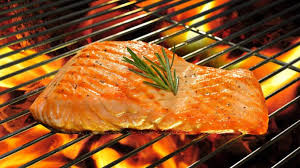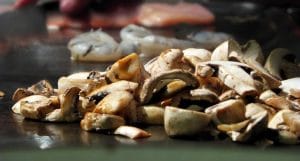Once you start grilling you’re bound to want to grill some salmon as well. And you can’t have grilled salmon without a nice garlic butter sauce.
But how do you grill salmon without it falling apart on your grill ?
And how do you get it to not stick ?
No worries, I’ve got you covered so you’ll have some char marks and smoky flavor on your salmon in no time.
What you’ll need for grilled salmon with garlic sauce
Grilled salmon is a simple dish to make, though it’s not exactly the easiest. There’s some preparation you need to make beforehand, and of course you need to know how to handle a grill.
So, this is what you’re going to need for grilled salmon with garlic sauce:
- 6 oz salmon fillet, per person
- a bit of vegetable or canola oil
- salt and pepper to taste
- 2 oz butter, unsalted
- half a lemon to use for the sauce and salmon
- 2 cloves garlic, minced
- 2 teaspoons parsley, roughly chopped (add more if you’re into parsley)
How to grill your salmon
For the salmon, you’re going to need to wash it under cold water very thoroughly. Some small scales may still be on the skin of the salmon. Those are alright, as long as they don’t get onto the meat itself. We’re not eating the skin.
In the meantime heat your grill to medium-high. It will take a few minutes, during which you’ll prep the salmon.
Make sure the fillets are evenly cut, so your don’t have different thickness from one end to the other. If one end is thicker it will cook slower, and the thinner part will end up dry and too flaky.
So, assuming you’ve got skin-on salmon, you will pat it dry on all sides. Salt and pepper to taste.
By this time the grill should be hot enough. A hot grill will be able to sear your salmon well enough, without it sticking.
Oil the grate just a little, but don’t overdo it or you’re going to get a burnt aroma.
Once the salmon is dry and seasoned, lay it gently onto the grill. Lay it facing away from you, skin side down. Cover, if your grill has a lid. If not, you can place some aluminium foil as a makeshift lid.
A few tips on grilling salmon
Look at the time.
You should let the salmon sit on the grill, without flipping, for 10 minutes. This is 10 minutes for each inch in thickness.
So if your filled is a very thick one (like 2 inches), add another 10 minutes. If it’s 1.5 inches, go for 15 minutes.
After the first 10 minutes, remove the lid. You should start to see some whitish fat rendering from the salmon. That’s alright, and it’s the sign you’re looking for.
If you’re unsure if now is the time to take the salmon off the grill, poke it gently with a spatula. It should be a bit springy, like a medium-rare steak.
If you’re still unsure, try separating a flake of the meat. If it moves easily, it’s done. If it falls apart as soon as you touch it, it’s gone too far.
When removing the salmon from the grill, use a wide spatula. There should be no sticking with this method, as the skin should be crispy and not cling to the grate.
Making the best garlic sauce at home

The garlic sauce will be easy enough to make, but you’ll have to move fast.
The two cloves of garlic will need to be grated, chopped or finely minced, depending on your mood. I recommend grating as this releases more flavor from the garlic.
If you really love garlic, you can add another clove. I don’t think anyone will mind.
To a hot saucepan or skillet add half the butter, and let it melt. Once it’s melted, add the garlic and stir until you can smell the garlic.
Do no burn the garlic, otherwise it will turn bitter.
This usually takes under 30 seconds, so don’t go anywhere !
Once the garlic’s done, remove the pan from the heat. Add the remaining butter, parsley, and some lemon juice. Exactly how much lemon juice you should add is up to you, and how icky you are about fish.
If you know you need a lot of help getting past the flavor, I recommend adding as much as 2 tablespoons of lemon juice. That’s going to turn the sauce quite sour, so keep that in mind.
If you want you can also grate a bit of lemon rind into the sauce. This will give it more of a lemon flavor, without adding any sourness like the zest.
Add salt and pepper to taste, remembering that the salmon is seasoned as well.
Once you’ve stirred everything in, spoon it over the grilled salmon, or place it in a dipping dish to share.
Two ways of grilling salmon so it doesn’t stick

There are 2 ways to grill your pieces of salmon so they don’t stick. Of course, getting your salmon skin-on will help immensely in keeping the whole thing in one piece.
But if you’ve got skinless salmon, there’s hope too.
1. Use skin-on salmon on an oiled grill grate
The first way to make sure your salmon doesn’t fall apart, and also doesn’t stick to the grill is to use skin-on fillets. The best part is that these are usually cheaper than skinless cuts.
The skin will keep everything together, but you’ll need a very hot grill in order to sear it well enough so it doesn’t stick.
Do not turn or flip the salmon at all, as it’s a very fragile piece of meat.
This means that when the skin on the bottom will be crisp, the actual meat after the skin is going to be nice and tender, but still holding together.
2. Use aluminium foil for skinless salmon
If you’re using skinless salmon then you’re going to need something to mimic the skin. For this I recommend thick aluminium foil, with a few holes punched through.
Use that as a sort of mini-plate onto the grill, and make sure you coat it with a bit of vegetable oil on the inside so the salmon will not stick.
As with the skin-on version, let it sit on the grill, covered, for 10 minutes for each inch of meat.
Once the time is up, remove the lid, and use a spatula to remove the fish. You might want to use two, if you’re afraid it will break apart as you pick it up.
Another version of this is to completely wrap the salmon in aluminium foil, and add a slice of lemon onto the meat, packed in.
As long as you’ve wrapped the foil very, very well, and possibly in a double layer, make a couple of holes on each side.
This will allow the fat to drip out, but will also allow some smoke to penetrate the salmon and keep it from being just steamed salmon.
You just have to be careful when turning it, which is why I recommend tightly wrapping the foil and using a reliable pair of tongs.
Conclusion
Grilling salmon with some nice garlic sauce sounds like a great way to kick off grill season, so I hope this post was able to help you out.
Salmon’s a bit finicky and handling it so it doesn’t fall apart means knowing when the meat is actually done.
It cooks very fast, and it’s actually going to be pink/light orange when you take it off the grill. If it’s very white, or just very pale it means your salmon’s dry. It needs to retain some of its fats, and one those are gone the meat will be fairly white.
Even if you don’t get your salmon right on the first try and it turns out a bit dry, I’m sure the garlic sauce will help things out.




